Artefacts from Vetera I that have been classified as toilet items are those related to personal hygiene, health and possibly beauty. These include the remains of mirrors, strigils, probes and tweezers. Some of these may have been surgical instruments but no distinction is made here. The distribution of such items in the Insula del Menandro in Pompeii (Allison n.d. 1) suggests that medical treatments, which today require specialised medical practitioners, might rather have been a type of first-aid in the 1st century CE. That is, minor surgery may have been practised as a more general household task than has occurred in more recent times. Thus, the distinction between personal or toilet activities and medical activities may have been more blurred than we tend to think. As Ralph Jackson has commented, the line between body care and medical healing in the Roman world is indistinct (Jackson, pers. comm.).
The situation within military installations may well have been different from that within domestic households, however. For example, in at least some forts and particularly large legionary fortresses like Vetera I, soldiers would no doubt have had better access to trained medical personnel than did Pompeian households. And, as argued by Baker (2001), the medical practices were likely to have varied across the Empire. Nevertheless, we should not discount that the types of objects listed above, and also found in Pompeian domestic contexts, would have been included among soldiers' personal hygiene equipment.
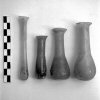
Figure 22: Unguentaria (inv. nos 5080A-D) from House I, 10,2, Pompeii (photo J. Agee)
Other artefacts from Vetera I have been categorised as possible toilet items, along with alternative classifications such as 'food preparation' or 'tableware and serving' where appropriate. Such items include small glass bottles, frequently referred to as unguentaria (for example, Isings 1957, 24; Kunina 1997, glossary; Fleming 1999, 4 pls 2-3; see de Tommaso 1990, esp. 19 n.1, 22) (Figure 22). While most evidence points to such vessels having been used for aromatic substances, cosmetics and medicaments, these may not have been their exclusive contents. There is also evidence, particularly from associations in Pompeian houses (Allison n.d. 1), which suggests that these vessels were used to hold food essences or condiments required in small quantities, or possibly paint. Small ceramic bottles and small glass bowls, cups and indeterminate fragments, have similarly been classified as 'toilet?'.
Glass bowls or dishes (with rim diameter mainly 100-200 mm), indeterminate glass vessel fragments, and bronze spoons, are categorised as 'tableware and serving?/toilet?'. While the larger of these vessels were probably used for tableware, this is by no means certain. In the assemblage above room 7 in the Casa del Fabbro in Pompeii, such bowls were found associated with personal items and artefacts that seem to have been for medical purposes (Allison n.d. 1). Other small glass cups and small glass bowls (with rim diameter <100 mm) are categorised as 'tableware and serving?/toilet?-drinking?'.
Large bronze sub-hemispherical basins with horizontal handles have been found in Pompeii in association with jugs with one or two vertical handles and these have been identified by Tassinari as sets used in ablutions, such as washing feet (1993, I, 232; see also Allison, n.d. 1). A similar basin is also depicted in a relief from Ostia, in which a baby is about to be washed (Kampen 1981, fig. 1). Handles of such basins have been recorded at Vetera I and so have been categorised as possible toilet items. Similarly, remains of bronze buckets have been included among possible ablution or toilet items and categorised as 'food-preparation?/toilet?'.
Remains of copper needles, of unidentified length, are categorised as 'cloth production?/toilet?' because large standard needles (length c. 150 mm) were also used in surgery (see Jackson 1994a, 204-5 nos A14 and A15; see also Jackson 1994b, 176-77). Fragments which could be either needles or pins are categorised as 'dress?/cloth production?/toilet?'.
The following queries were run to investigate the distribution of toilet activities. The first query mapped the distribution of remains of all artefacts unequivocally identified as toilet items and the second query mapped the distribution of all artefacts that could conceivably have been related to toilet activities.
Following a review of legacy systems and in line with broader ADS practice, the interactive map element of this article has been decommissioned. The full underlying set of data is still available for download from the digital archive.
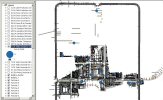
Screendump of ArcGIS query - (T1), certain toilet items
There are eighteen items in the catalogue identified as toilet items, but only sixteen of these could be plotted in known trenches. One probe was from the surface and unprovenanced and a strigil from Trench 308 (in a pit to the north of Building A) could not be plotted. Of the sixteen that could be plotted, two were outside the Neronian fortress. Those within the fortress are all single and dispersed finds. One was found in each of the north and east gateways, and another two were found in the main cross street, the via principalis. Of those found within the actual buildings, one probe was found in barracks N, two probes in the tribunes' houses K and M, another two probes in Building T, two mirror fragments in the central administrative building, Building A, and a mirror fragment in the legate's palace, Building P. Another mirror found in Trench 750 could conceivably also have been from palace P. One in Trench 64, in the north-east area of the fortress, and possibly the strigil in Trench 308, were from pre-Claudian contexts. None of the items plotted within the buildings were found in pits.
Although the numbers are extremely limited, there is perhaps a predictable pattern, with toilet items in residences or lost in the street. The lack of any toilet items in palace H is not surprising given that there is a general lack of finds in this building (Allison n.d. 2, esp. fig. 10; see Section 8.7.6). More surprising are mirror fragments in Building A, although at least one of them is likely to have been from pre-Claudian contexts in the building's foundations. The lack of such items in Building Z, identified as the hospital, but their apparent concentration in Building T, are perhaps more noteworthy. While the quantities are essentially too insignificant to draw conclusions, one could perhaps be open to the possibility of habitation, or at least toilet activities, within Building T and an incorrect identification of Building Z.
There are many more of these types of items, adding more complications to the distribution pattern of possible toilet items (T2). They are therefore examined according to individual type.
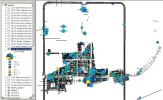
Screendump of ArcGIS query - (T2), all possible toilet items
The most prolific artefacts are remains of glass dishes or bowls (with rim diameters ranging from 80-200 mm), indeterminate glass fragments, and bronze spoons, which could alternatively have been tableware and serving items (ZTS_T). These have a fairly wide distribution but, within the area of the excavated central buildings, there are concentrations in: the front parts of Buildings Z, Y and a, on either side of the via principalis near the west gate; tribune's house M; palace P and Building S; the open area in front of Building A; and in the buildings fronting the south side of the via principalis, towards the east gate, notably Buildings T and U. One in Building a, one near the east gate, and one in Building M were in pre-Claudian contexts. Such items were present in the central administrative buildings, A-B and G, but in comparatively limited numbers. At least one of the four found in Building G, was from a pre-Claudian context. If these items were indeed toilet items then their concentrations in Buildings M and Z might be expected. Less expected is their presence in what were possibly more public buildings along the via principalis, identified by Lehner (1930, 39) as shops. It has been noted that these are also the locations for concentrations of ceramic tableware (Allison n.d. 2, figs 5-6), suggesting that these glass vessels were perhaps more usually tableware than toilet items. One item found in Trench 1512 and one in Trench 119 could not be plotted.
Also relatively prolific were small glass bowls and cups (rim diameter less than 100 mm), which may equally have been tableware items, possibly drinking cups (ZTS_TD). The remains of these are likewise fairly widely distributed. In the central excavated area of the fortress, there were no real concentrations, but their presence is again noteworthy in: buildings opening onto the via principalis, particularly near the east gate; the open area in front of Building A (one in a pre-Claudian context); Building a; palace H; and Building F. There was also one such item in Building N, two in tribune house M and one in the central administrative Building A. One of the three recorded in Building G was from a pre-Claudian context, as was one from Buildings C and D. One found in Trench 1332 could not be plotted. The general impression is that these bowls are not concentrated in particularly private areas, but rather in what would seem more public areas. They, again, may in fact be tableware rather than toilet items.
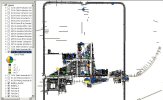
Screendump of ArcGIS query - (T3), possible toilet items (excluding glass bowls)
By comparison only limited amounts of other possible toilet items were recorded (T3). The next most prolific are glass and ceramic unguentaria and bronze basins (ZT). There are twenty-three items of these types recorded at Vetera I, of which one in Trench 308 could not be plotted. Their distribution is, in some respects, comparable with that of the certain toilet items. They are from contexts predominantly identified as Claudian-Neronian and concentrated in tribunes' houses J and M, the open area in front of Building A, and Building F. One from Trench 582, which could not be plotted, was also from Building J. These items are also present in the vicinity of the north and east gateways, in front of barracks V and in palace P, and four were found in the administrative buildings, Buildings A and G. One of the latter, and possibly the one in the east gateway were from pre-Claudian contexts. The concentration in Building F is potentially the most interesting.
Only five needles and needle fragments (ZC_T) and (ZD_C_T) , which could conceivably have been toilet items, were found: one in the portico in front of barracks V, two in the area in front of Building A; one in Building B (possibly pre-Claudian); and one north of barracks Y. The distribution of these limited and easily lost items is, on its own, probably not significant.
Bronze buckets may have been used in ablutions but also for carrying water for other purposes, such as food preparation (FP_T). Remains of two were found near the via principalis, in front of Building F (dot hidden on screen dump) and barracks Y. One was in Building a and another in the south-east area of Building G. Given the distribution pattern of the glass bowls and ceramic tableware, the location of the former two might indicate their association with food preparation (see Allison n.d. 2, fig. 7). The location of the last one suggests that we might consider looking at the south-west area of Building G as either a potential food-preparation area or an area for personal hygiene activities. The lack of any other toilet items but the presence of other food-preparation items in this area, suggests that it was more probably a food-preparation area. However, this is by no means conclusive without further analysis.
In summary, the uncertain toilet items that are most likely to have been toilet items follow a similar distribution pattern to the more certain toilet items. That is, they are concentrated in the officers' residences, on the south side of the eastern end of the via principalis and near the east gate but also have a notable presence in the central administrative buildings.
It is very difficult to ascribe gender convincingly to items used in toilet activities. The exception is perhaps razors but, interestingly, none were recorded here. Mirrors and tweezers were very probably used by men and women. Kampen commented that (1996, 22) mirrors have been 'symbolically associated with women' since Greek times. However, in practice, as Wyke has noted (1994, esp. 135-38), mirrors were also likely to have been used by males. Allason-Jones has also argued (1995, 28) that the presence of tweezers in the turrets on Hadrian's Wall indicates that they could have been male personal hygiene equipment. Likewise, from their presence in the turrets on Hadrian's Wall, Allason-Jones has argued (1995, 28) that needles were used by soldiers who would have needed to do their own mending. Thus, she has argued against a direct association between women and needles. The use of needles in surgical activities also argues against any direct association between women and needles. Therefore, most toilet items have been categorised as 'male?/female?'. Glass bowls, glass cups and indeterminate glass items (ZTS_T) and (ZTS_TD) have been excluded from this plot as many of these may well have been tableware and therefore have not been gendered.
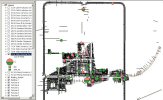
Screendump of ArcGIS query - (T4), gendered toilet items
If any of these toilet, or possible toilet, items could be categorised as women's items the most likely would be the unguentaria given their traditional association with aromatic substances and cosmetics, particularly glass unguentaria. Of the thirteen unguentaria from the central excavated area, five were found in the open area in front of Building A and in Building F; three in Building G (one in a pre-Claudian context), one in Building A; one in the east gateway; two in the tribunes' houses J and M; and one in Building L. Thus potentially female toilet items predominate in the vicinity of the tribune houses and of the central open area, which was possibly a market place (Lehner 1930, 40). This pattern should be borne in mind while investigating the distribution of items more convincingly associated with women (see Section 8.6).
The pattern for the distribution of personal hygiene items at Vetera I is perhaps disappointingly uninformative, not least because the quantity of artefacts is very low, with the exception of glass bowls and dishes which are dubious toilet items. Nevertheless, a number of toilet items were found in buildings identified as residential, and in Building T, but notably not in the hospital, Building Z (see Section 8.7).
© Internet Archaeology
URL: http://intarch.ac.uk/journal/issue17/4/8.1.html
Last updated: Mon Apr 4 2005